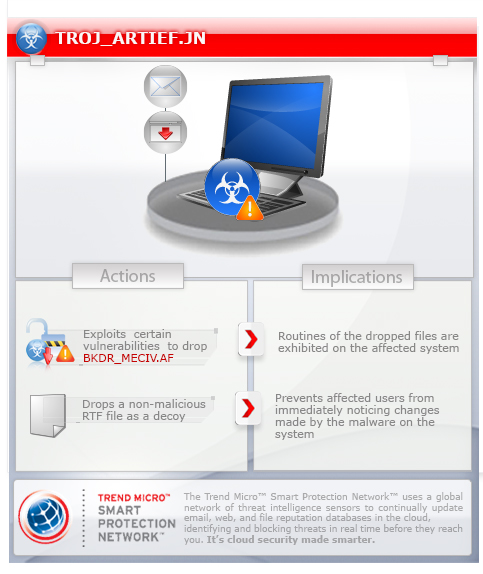TROJ_ARTIEF.JN
Exploit:Win32/CVE-2012-0158 (Microsoft), PAK:Ole2Rtf, Exploit.Win32.CVE-2012-0158.j (Kaspersky), Trojan Horse (Symantec), Exploit-CVE2012-0158!rtf (NAI), Exp/20120158-A (Sophos), Exploit.CVE-2012-0158.Gen (FSecure), Exploit.MSWord.CVE-2012-0158 (v) (Sunbelt), EXP/CVE-2012-0158 (Antivir), Exploit.CVE-2012-0158.Gen (Bitdefender), MSOffice/CVE20120158.fam!exploit (Fortinet), Exploit.Win32.CVE-2012-0158_OLE (Ikarus), Win32/Exploit.CVE-2012-0158.G trojan (NOD32)
Windows 2000, Windows XP, Windows Server 2003


Threat Type: Trojan
Destructiveness: No
Encrypted: Yes
In the wild: Yes
OVERVIEW
Spammed via email, Dropped by other malware, Downloaded from the Internet
Both malware are related to the modified Enfal variants, which were reported to have infected 874 systems in 33 countries.
To get a one-glance comprehensive view of the behavior of this Trojan, refer to the Threat Diagram shown below.

This Trojan arrives as an attachment to email messages spammed by other malware/grayware or malicious users. It arrives on a system as a file dropped by other malware or as a file downloaded unknowingly by users when visiting malicious sites. It may be manually installed by a user.
It executes the dropped file(s). As a result, malicious routines of the dropped files are exhibited on the affected system.
It deletes itself after execution.
TECHNICAL DETAILS
145,739 bytes
RTF
24 Jul 2012
Drops files
Arrival Details
This Trojan arrives as an attachment to email messages spammed by other malware/grayware or malicious users.
It arrives on a system as a file dropped by other malware or as a file downloaded unknowingly by users when visiting malicious sites.
It may be manually installed by a user.
Installation
This Trojan drops and executes the following files:
- %User Temp%\hkcmd.exe - detected as BKDR_MECIV.AF
(Note: %User Temp% is the current user's Temp folder, which is usually C:\Documents and Settings\{user name}\Local Settings\Temp on Windows 2000, XP, and Server 2003.)
It drops the following non-malicious file:
- %User Temp%\{Malware Filename}.rtf - used as decoy by this Trojan.
(Note: %User Temp% is the current user's Temp folder, which is usually C:\Documents and Settings\{user name}\Local Settings\Temp on Windows 2000, XP, and Server 2003.)
Dropping Routine
This Trojan takes advantage of the following software vulnerabilities to drop malicious files:
It executes the dropped file(s). As a result, malicious routines of the dropped files are exhibited on the affected system.
Other Details
This Trojan deletes itself after execution.
SOLUTION
9.200
9.328.09
24 Jul 2012
9.329.00
25 Jul 2012
Step 1
For Windows XP and Windows Server 2003 users, before doing any scans, please make sure you disable System Restore to allow full scanning of your computer.
Step 3
Scan your computer with your Trend Micro product and note files detected as TROJ_ARTIEF.JN
Step 4
Search and delete this file
- %User Temp%\{Malware File name}.rtf
Step 5
Scan your computer with your Trend Micro product to delete files detected as TROJ_ARTIEF.JN. If the detected files have already been cleaned, deleted, or quarantined by your Trend Micro product, no further step is required. You may opt to simply delete the quarantined files. Please check this Knowledge Base page for more information.
Step 6
Download and apply these security patches Refrain from using these products until the appropriate patches have been installed. Trend Micro advises users to download critical patches upon release by vendors.
Did this description help? Tell us how we did.

